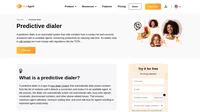What is a dialed number identification service?
Dialed number identification service (also known as DNIS) is a telecommunications service sold to companies that enables them to determine which number a customer dialed to reach them. To allow DNIS service, the phone company sends a DNIS number to the receiving phone network before connecting the call. The DNIS number, which typically represents a sequence of 4 to 10 digits, is then used to effectively route incoming customer calls in order to achieve efficient telephone service provided by a company.
DNIS data is rarely used alone. Along with other call identification features, dialed number identification service finds a wide usage in companies with separate numbers for different locations or diverse product lines. When used with toll-free numbers, the corporate telephone system receives an incoming customer call and routes it to an appropriate department or a specific IVR (Interactive Voice Response) menu based on the DNIS information. This is particularly helpful for call centers with typically high incoming calls volumes.
How does dialed number identification service work?
In tech terms, dialed number identification service works by transmitting the DTMF (dual-tone multi-frequency) digits to the processing unit. A special mechanism will decode “the signals” and either displays them or make them available to the call processing application at the receiving end. ACD (automatic call distribution) is at the core of omnichannel routing employs DNIS as the primary call routing mechanism. In practice, it means that when customers call the organization’s call center using one of their phone numbers, the call center software can employ DNIS routing to direct those inbound phone calls to the correct departments, agents or trigger different IVR scripts.
Built-in call center with awesome features
Sign up for a 30-day free trial and discover all that LiveAgent has to offer.
Overall, DNIS ensures an effective process for telephone communications with customers and assists organizations in delivering exceptional customer experiences. Apart from routing the incoming customer calls to the right recipient, it can also trigger appropriate messages for callers in customized IVR scripts based on the destination number dialed by the caller. Here are some examples of how DNIS is used in call centers.
- Supporting multiple product lines
A call center may provide different toll-free numbers for each product line it supports. The DNIS helps distinguish between these lines and plays appropriate IVR scripts or routes inbound calls to agent groups with matching skill sets.
- Multilingual customer support
A call center handling multiple geographical locations may offer different toll-free numbers for each supported language. The DNIS data is used to route client phone calls to suitable agents based on the language requirements.
- Multi-client support by a single agent
If a single call center agent is assigned to manage multiple client accounts or multiple product lines from a single account, DNIS can be used to classify the call purpose and help the agent deliver efficient support.
- Improving call center metrics
DNIS helps improve some of the most critical call center metrics, such as first call resolution rates, agent performance, and customer satisfaction scores via accurate call routing.
- Streamlined call center operations
DNIS plays a key role in streamlining call center operations. For example, based on the DNIS information, the call center server can decide whether an incoming call should be queued and connected to an appropriate agent or agent group or directed to a specific IVR self-service menu.
What is the difference between dialed number identification service (DNIS) and automatic number identification (ANI)?
ANI (Automatic Number Identification) is a telecommunications feature that provides the phone call recipient with the caller’s originating number. To eliminate the need for telephone operators to manually request the number of the calling party for a toll call, AT&T created ANI for the purposes of internal long-distance billing.
Dialed number identification service (DNIS) and automatic number identification (ANI) are both features of the telecommunications network — designed to provide the recipient of a phone call with more information about the incoming connection.
While DNIS identifies the number that the caller dialed, ANI displays the phone number setting up the connection. Therefore, DNIS and ANI differ in whether they provide the original destination number dialed or the source phone number to the recipient.
Call and respond
Gain complete control over the flow of the outbound and inbound calls with LiveAgent's call center software.
Frequently Asked Questions
What is dialed number identification service?
Dialed number identification service (DNIS) is a service offered by telecom providers that helps the call receiver to identify the number the caller dialed. Call centers that have high inbound call volumes and multiple lines coming in, are the target consumers of DNIS services. DNIS supports call center software in efficient call routing and call handling processes. It also determines which IVR script should be triggered based on the number dialed by the caller.
How does dialed number identification service work?
DNIS works by transmitting the dual-tone multi-frequency digits (typically 4 to 10 digits) that the caller dialed to the client phone system during the call setup. This data is then used for efficient inbound call routing and allows directing the caller to the appropriate agent or agent group. For example, a call center may provide several toll-free numbers for different product lines or multilingual customer support. DNIS ensures the callers will be routed to the agents best suited to meet their needs.
What is the difference between dialed number identification service and caller ID?
Dialed number identification service (DNIS) and Caller ID - which is somewhat similar to automatic number identification (ANI) - are intended to provide the phone call recipient with the actual phone number of the incoming call when the call is being set up. But DNIS is designed to give the call recipient the original destination number. At the same time, the Caller ID provides the number of the original caller (along with the caller’s name, if available.
After learning about the dialed number identification service, you might wonder, "What is a dialed number identification service?" This article will give you a deeper understanding of how this service functions. Additionally, if you're curious about the mechanics, check out the section on how dialed number identification service works. For those interested in technical comparisons, there's an insightful explanation on the difference between dialed number identification service (DNIS) and automatic number identification (ANI). Lastly, if you're looking to boost your skills, don't miss the tips on how to improve your customer service.
Understand call centers: function, benefits, and ROI impact
Discover the ins and outs of call centers, their benefits, common challenges, best practices, and future trends that can shape the industry.

 Български
Български  Čeština
Čeština  Dansk
Dansk  Deutsch
Deutsch  Eesti
Eesti  Español
Español  Français
Français  Ελληνικα
Ελληνικα  Hrvatski
Hrvatski  Italiano
Italiano  Latviešu
Latviešu  Lietuviškai
Lietuviškai  Magyar
Magyar  Nederlands
Nederlands  Norsk bokmål
Norsk bokmål  Polski
Polski  Română
Română  Русский
Русский  Slovenčina
Slovenčina  Slovenščina
Slovenščina  简体中文
简体中文  Tagalog
Tagalog  Tiếng Việt
Tiếng Việt  العربية
العربية  Português
Português 







